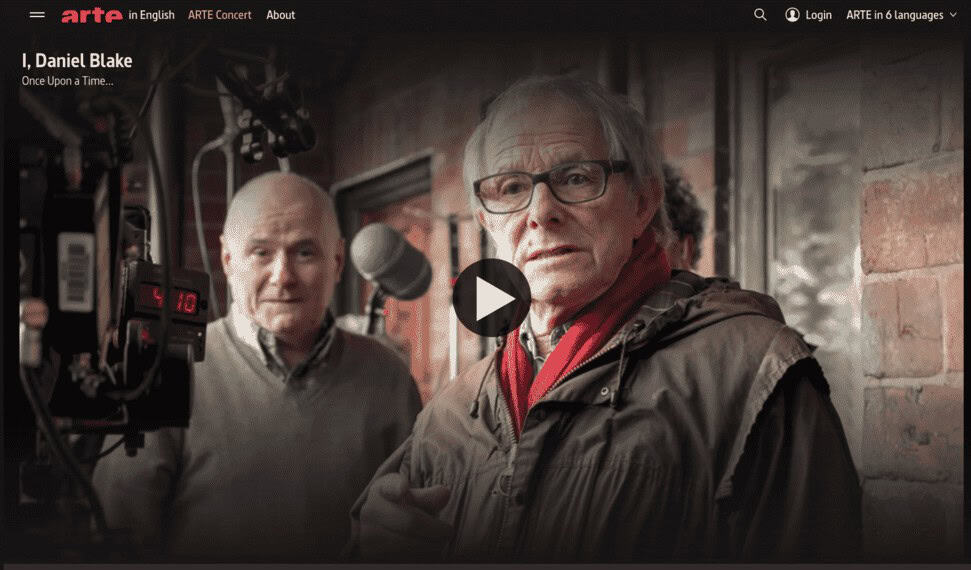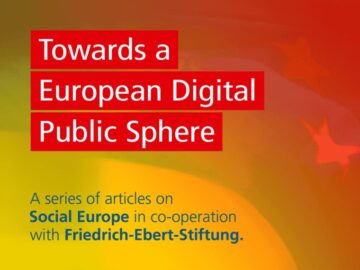A European digital public sphere need not be constructed de novo. Many elements already exist to be cohered.

The European public sphere has become dysfunctional. Against this background, a debate has unfolded in recent years about a European digital public sphere (EDPS), exploring the possibilities of how another communicative digital infrastructure can emerge—not subject to the deformations resulting from the dominance of the United States digital giants of ‘GAFAM’ (Google, Apple, Facebook, Amazon, Microsoft).
The idea is there as a rough sketch: a public space for digital communication in Europe should make knowledge and content generated with public funds digitally accessible and useable for a broad public. In the debate on this European digital sphere, the perspective has evolved from a super-platform to a decentralised model of networked platforms.
Approaches to the realisation of these ideas are manifold. Grassroots organisations, digital initiatives, cultural platforms, civil-society networks, ‘wikis’ and many more are working on this. An overview lists a wealth of advocates of an internet for the common good—there are more and more every week. Looking at the nodes of this large network, some stand out.
Public-service media
EPOS (European Public Open Spaces) is the upshot of scholars who wanted to stimulate open arenas in digitally-networked public space. It is concerned with ‘spaces that serve the public interest, are free of state and market influences and have a European dimension’. The project recognises that public-service media remain, also in the digital-media world, one of the most important places for public policy, culture and integration.
Four constitutive elements are envisaged: public-service media themselves and public knowledge institutions such as Europeana—a network of almost 4,000 cultural organisations across Europe—as well as civil-society institutions such as Wikipedia and citizens. Civil-society knowledge alliances, such as Open Access Science, Free Software, Wikipedia and Open Educational Resources, which advocate quality-assured, relevant, source-based knowledge for the common good and free and universal access, are a natural partner for public-service media that share the same values.
From the outset, public-service broadcasters have played an important role in the idea of a European digital public sphere. While Ulrich Wilhelm, former chair of ARD, the network of German state broadcasters, recommended that public and commercial media should appear together on one platform, Karola Wille, director of the the ARD constituent MDR, argues for a communication network oriented towards the common good.
Public-service providers are working on the realisation of platforms which contain elements of the above ideas. The cultural platform of ZDF, another German channel, unites more than 50 institutions which make their content available digitally. And the Franco-German cultural channel ARTE, with four partners (including ARD and ZDF), publishes the European Collection, bringing together reports on social reality from all over Europe on one platform.
European digital infastructure
A paper by Acatech, the German National Academy of Science and Engineering, which is funded by the federal and state governments, advocates a sovereign European digital infrastructure, democratically accountable to citizens, which enables further offers and platforms. In this context, the public-service media are not seen as prominent players but as one content provider among others.
To develop this system, a governance unit, a European digital agency or network, together with an alliance of European actors—including providers of content, services and infrastructure components, civil-society initiatives and research institutions—is considered necessary. So too is state funding, in conjunction with a European regulation.
A group of scholars have launched the Public Service Media and Public Service Internet Manifesto, which proclaims a series of principles to safeguard the democratic functioning of public-service media in the digital space. Among them: ‘An Internet that promotes democracy requires public-service media that become public-service internet platforms which help to promote opportunities and equality in society. We call for the legal, economic and organisational foundations for such platforms to be created.’
The manifesto emerged from an exchange between academic experts and key public-service media actors, ‘InnoPSM—Research Network on Innovation in Public Service Media Policies’. A research agenda was developed, across national and disciplinary boundaries, to drive forward innovative policy solutions and strategies to cope with the major digital challenges facing public media.
Last, but not least, there is the International Association of Public Media Researchers. This brings together more than 300 academics and media professionals worldwide, with a focus on public-service-media research and innovation.
Diversity and creativity
Other initiatives which combine the idea of a platform with a European and democratic perspective but do not always take public media into account to this extent can be examined for their affinity. Interaction among very different actors will bring the diversity, creativity and inclusivity a European digital communicative sphere needs.
The Free Software Foundation has been campaigning for many years for more open standards and interfaces in technological development. The Beyond Platforms Initiative is an alliance of media players working to develop innovative solutions for a digital public space oriented towards the common good. The European Broadcasting Union is developing components of infrastructure in a Personalisation and Recommendation Ecosystem (‘Peach’) which aims to make algorithms more transparent and diverse. And Public Stack in Amsterdam creates open, democratic and sustainable digital public spaces at the local level and sees this also as a task for Europe.
Some of these initiatives have created Shared Digital European Public Spaces (SDEPS), a pan-European coalition which wishes to create a distributed, diverse, open and connected European digital public sphere. Since each of the start-up initiatives is itself a network of public-service media, community media, Wikimedia, libraries, archives, festivals and colleges, they have the potential to be the hubs of a broader movement.
While global internet players build on comprehensive tracking of user behaviour to create detailed personal profiles sold to advertisers, the SDEPS coalition is striving for a technological alternative: ‘The goal is to embed the fundamental values of [the] EU and Internet by design into each of the components [free software modules for online platforms and services], and thereby into each of the platforms and services and into the common architecture of the entire interoperable ecosystem.’
Given the complexity and scale of the task, the coalition is demanding from the EU an action plan for the European digital public space. There are however many unresolved questions, of which funding, governance and the language framework are certainly the most urgent.
Important task
In recent years, the prevailing opinion has been that public-service broadcasting should be cut back and become leaner—a view stamped by the self-interest of commercial media actors. Yet in view of the scale of the task and the fact that users’ media budgets are growing, it is difficult to accept that such an important task should not be appropriately funded.
If public-service media are to become platforms or be involved in the creation of platforms, quality parameters must be developed which leave the shortcomings of commercial platforms behind. A public open space must not only offer as many services as possible but also be user-friendly, accessible via various devices and, above all, searchable. Users should be confident they will find services that meet the highest journalistic and ethical standards.
The idea of a network of platforms oriented towards the common good should be openly elaborated and allow the coming together of different actors, so that the diversity which should contribute to inclusion and social solidarity can be realised. The public should be given a variety of opportunities to participate through evaluation and comment functions.
Data security, which ensures the protection of personal data and prohibits data misuse, must be guaranteed. The relevance of the services and contents for democratic discourse is for such a network the supreme criterion, which must be fulfilled if the alliance of the various actors is to be successful.
Far-reaching solutions
The glaring shortcomings of the currently dominant commercial digital platforms make it necessary to think about a corresponding non-commercial offer of appropriate size. Only large institutions are however in this position and their experiences of steering and co-operation oriented towards the common good must be drawn upon. A European digital public space must be comprehensive and this requires far-reaching solutions. Future projects must think beyond the pragmatics of the next possible fix and venture into the unknown.
This requires that public-service providers step away from their own certitudes and defensive stances. New alliances must be sought and found in all areas where publicly-funded knowledge and cultural content are generated and exchanged.
Hitherto, public-service media could pull together and inspire a large part of the population. Their potential must be developed in a digital public space of European dimensions, in which various population groups can exchange ideas and participate in the richness of European culture and in which quality information makes democracy tangible.
Realisation of these goals, on platforms of relevant scale, demands enormous effort, strong actors and much readiness to collaborate. But this effort will be worthwhile to create the public spaces Europeans need in the digital media world.

This is the third article in a series on a European digital public sphere, supported by the Friedrich Ebert Stiftung with an eye to its Digital Capitalism conference between November 15th and 19th. All articles in this series are published under a Creative Commons licence.
Barbara Thomass is professor emerita at Ruhr-University of Bochum for international comparison of media systems and a senior researcher at Leibniz Institute for Media Research | Hans-Bredow-Institute in Hamburg.She is the second deputy head of the administrative council of the ZDF, the national public-service broadcaster in Germany.

